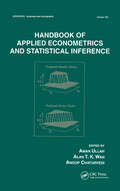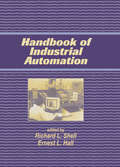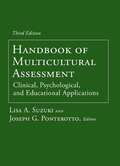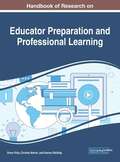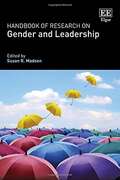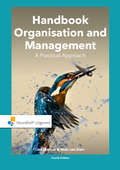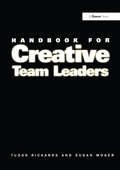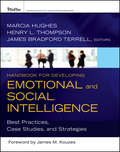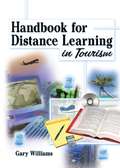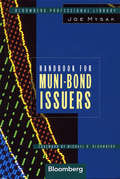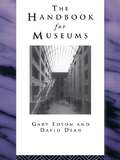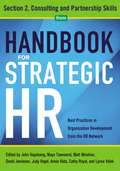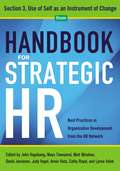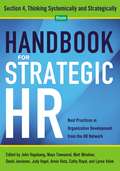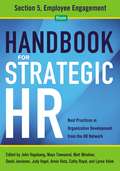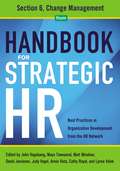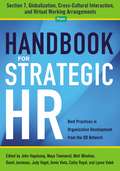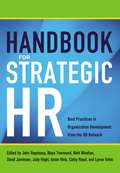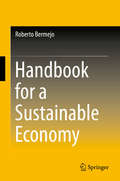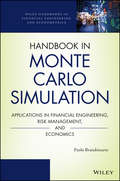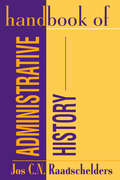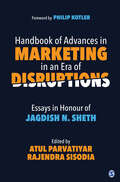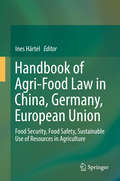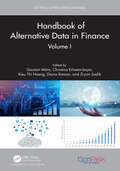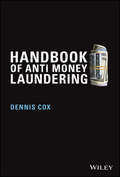- Table View
- List View
Handbook Of Applied Econometrics And Statistical Inference
by Aman UllahSummarizing developments and techniques in the field, this reference covers sample surveys, nonparametric analysis, hypothesis testing, time series analysis, Bayesian inference, and distribution theory for applications in statistics, economics, medicine, biology, engineering, sociology, psychology, and information technology. It supplies a geometric proof of an extended Gauss-Markov theorem, approaches for the design and implementation of sample surveys, advances in the theory of Neyman's smooth test, and methods for pre-test and biased estimation. It includes discussions ofsample size requirements for estimation in SUR models, innovative developments in nonparametric models, and more.
Handbook Of Industrial Automation
by Richard ShellSupplies the most essential concepts and methods necessary to capitalize on the innovations of industrial automation, including mathematical fundamentals, ergonometrics, industrial robotics, government safety regulations, and economic analyses.
Handbook Of Multicultural Assessment: Clinical, Psychological, And Educational Applications
by Joseph G. Ponterotto Lisa A. SuzukiHandbook of Multicultural Assessment offers the most comprehensive text on testing of racial and ethnic minorities in the United States. This thoroughly revised and updated edition includes the most current and state-of-the-art assessment information in a variety of psychological and educational domains. The book highlights new and innovative testing practices and expands the populations of interest to include recent immigrants and refugees. It also includes ways to overcome barriers in the assessment process as well as forensic assessment. This important resource offers an instructional text for conducting culturally competent psychological assessment for clinicians, educators, and researchers.
Handbook Of Research On Educator Preparation And Professional Learning
by Drew Polly Christie Martin Kenan DikilitaThe current climate in education environments necessitates the collaboration on and sharing of research done by teacher educators and professional developers. In an era of high-stakes assessment driven by international tests, professionals are looking for research-based or evidence-based initiatives and approaches to enhance teacher learning, which will in turn impact student learning. The Handbook of Research on Educator Preparation and Professional Learning is a critical scholarly publication that examines pedagogy for educator preparation and growth for classroom expertise. This book features a wide array of topics such as online environments, project-based learning, and urban education. This book is ideal for educators, administrators, professional developers, academicians, policymakers, and researchers.
Handbook Of Research On Gender And Leadership (Research Handbooks In Business And Management Series)
by Susan R. MadsenAlthough some progress has been made in recent decades in getting women into top positions in government, business and education, there are on-going, persisting challenges with efforts to improve the opportunities for women in leadership. The Handbook of Research on Gender and Leadership comprises the latest research from the world's foremost scholars on women and leadership, exposing problems and offering both theoretical and practical solutions on how to best strengthen the impact of women around the world. The Handbook provides a brief overview of the current state of women in global leadership, explores theories (both established and emerging) focused specifically on women, and examines with both theoretical and empirical research some of the factors that influence women's motivations to lead. The authors delineate some of the most persistent barriers to women's leadership success and conclude with the latest research findings on how to best develop women leaders to improve their status worldwide. Handbook of Research on Gender and Leadership will appeal to scholars and advanced students in leadership and entrepreneurship. It will be essential reading for leadership coaches, practitioners and business people, particularly those who facilitate leadership programs for women.
Handbook Organisation and Management: A Practical Approach (Routledge-Noordhoff International Editions)
by Jos Marcus Nick van DamA hands-on introduction to the fields of business and management, this comprehensive text unveils the theories behind management and organization via a practice-led, international approach. In this fourth edition, the book expands with six new chapters on digital business transformation, internationalization, corporate social responsibility, the future of work, human resource management, and culture. In addition, the book contains new, topical practical examples, and features a fully modernized layout. This comprehensive, practice-led text will be valuable for students of business, management and organisation globally. A companion website offers students multiple choice questions, practical cases, and assignments, whilst instructors can assess exams, cases, and college sheets.
Handbook for Creative Team Leaders
by Susan Moger Tudor RickardsEvery worthwhile organization strives continuously to improve. What the authors of this groundbreaking book offer is nothing less than a system for achieving peak performance. As a result of their work with more than 2000 teams, in some 40 countries across the globe, the authors identified the 7 factors that distinguish what they call ’dream teams’ and on that basis they developed the structured approach described in the Handbook. Part I sets out the principles that underlie team performance. Part II shows how to train teams to become more creative. Finally, in Part III, the authors demonstrate their ideas in action with real-life examples from a wide variety of organizational settings. They emphasize throughout the role of leadership in stimulating creativity and innovation, and they explain how to inject new dynamism into existing organizational systems and practices. Anyone involved in teamworking would profit from a close study of the Handbook. It will be especially valuable to team leaders and facilitators, to project managers and to HRD practitioners and consultants.
Handbook for Developing Emotional and Social Intelligence
by Henry L. Thompson James Bradford Terrell Marcia HughesHandbook for Developing Emotional and Social Intelligence is an authoritative collection of practical content--best practices, case studies, and tools--that showcases the application and development of emotional and social intelligence in the workplace. The authors are some of the best-known experts in the field and the book includes practitioners, academics and thought-leaders that contributed to this rich collection of knowledge and solutions that will appeal to anyone involved in developing leaders and teams. The handbook features topics such as leadership, recruitment, conflict resolution, team development, and stress management.
Handbook for Distance Learning in Tourism
by Kaye Sung ChonDeliver quality instruction to your students-on-campus or offThe Handbook for Distance Learning in Tourism is a practical, down-to-earth guide to developing and using print-based and Internet-based flexible learning resources for courses where students rarely, if ever, attend on-campus classes. Whether you&’re a teacher who needs to develop course notes into a flexible learning package, a Web site, or both, or you just want information about how to teach in a flexible environment, the book will provide the help you need-in language you can understand. Designed to guide you through the completion of a project-or a semester-this hands-on book offers strategies, suggestions, hints, and examples, and includes a hotel and tourism case study that illustrates effective concepts and strategies.Written by Gary Williams, co-editor of The Internet and Travel and Tourism Education (Haworth), this unique book will help you develop print-based and Internet-based learning resources instead of focusing only on one or the other, breaking down the barriers placed between learning environments. The strategies presented are timeless, with no comparisons of specific commercial or noncommercial products to become outdated and no Web site addresses to become useless. The book makes extensive use of tables, graphics, and illustrations and has its own Web site that&’s regularly updated, listing online resources arranged on a chapter-by-chapter basis.The Handbook for Distance Learning in Tourism examines: the roles and characteristics of a project manager developing and buying resources considerations before committing to a project maximizing project ownership ensuring quality content educational design guidelines media foundations production, design, and maintenance of print resources developing and using Web sites computer-mediated contact course management systems (CMS) and much more!The Handbook for Distance Learning in Tourism is an invaluable guidebook for educators working in the field of hotel and tourism management as well as academics, project managers, and educational designers who are interested in flexible learning developments.
Handbook for Muni-Bond Issuers (Bloomberg Financial #18)
by Joe MysakFrom Bloomberg, the authority on municipal bond valuation, this is the first book to give issuers (municipalities and their officers, attorneys, and other advisers) step-by-step tips on (1) lowering the cost of financing and (2) how to do it right and avoid trouble--with the press, with the market, with constituents, and with the Securities and Exchange Commission. With an insider's perspective, Joe Mysak debunks the myths and reveals thepractical realities of today's municipal bond market. Fresh and clearly written, this excellent primer on issuing municipal bonds is a key to the market that no participant should be without.
Handbook for Museums (The\heritage: Care - Preservation - Management Ser.)
by David Dean Gary EdsonHandbook for Museums is the definitive guide of need-to-know information essential for working in the museum world. Presenting a field-tested guide to best practice, the Handbook is formed around a commitment to professionalism in museum practice. The sections provide information on management, security, conservation and education. Including technical notes and international reading lists too, Handbook for Museusms is an excellent manual for managing and training.
Handbook for Strategic HR - Section 2: Consulting and Partnership Skills
by John Vogelsang Maya Townsend Matt Minahan David Jamieson Judy Vogel Annie Viets Cathy Royal Lynne Valek Od NetworkThe role of the HR professional has shifted from personnel administrator to business adviser, which includes consulting and partnering with the organization’s leadership and other service providers. This section will help you learn what core skills are needed for consulting; how to develop partner relationships to support innovation and change; how to work with clients in a consultative mode; and how to deal with the challenges of being an internal consultant.
Handbook for Strategic HR - Section 3: Use of Self as an Instrument of Change
by John Vogelsang Maya Townsend Matt Minahan David Jamieson Judy Vogel Annie Viets Cathy Royal Lynne Valek Od Network“Use of self” is what Organizational Development practitioners call the complex set of awareness and behaviors that make it possible to be genuinely helpful to others. Effective use of self is essential for influencing change in an organization. This section will help you understand how your assumptions influence your behavior and your perception of others; how to counter covert dynamics in the workplace that undermine productivity; how to encourage ethical leadership; how to foster inclusion; and how to continually learn about greater self-awareness and better working relationships with colleagues.
Handbook for Strategic HR - Section 4: Thinking Systematically and Strategically
by John Vogelsang Maya Townsend Matt Minahan David Jamieson Judy Vogel Annie Viets Cathy Royal Lynne Valek Od NetworkThinking systemically and strategically means moving beyond a focus on the individual to understand the larger organizational and environmental systems and how the dynamics of those systems impact work performance and the readiness for change. This section will explain how certain problems recur and are often made worse by quick solutions; how one decision can impact many people and set in motion a situation that can create numerous unexpected outcomes for the organization; and how to decide where best to begin fostering change—with individuals, groups, departments, the organization (policies, practices, culture, etc.), or the external market/community relationship.
Handbook for Strategic HR - Section 5: Employee Engagement
by John Vogelsang Maya Townsend Matt Minahan David Jamieson Judy Vogel Annie Viets Cathy Royal Lynne Valek Od NetworkEmployee engagement makes a difference. HR professionals know this intuitively and so do leaders. They want employees to care about their work and actively engage with the job and the organization. But now we know that employee engagement is not just something that makes intuitive sense. It also reaps financial rewards. This section provides case studies, hard data about what is effective, and proven techniques for increasing employee engagement in the important work of the organization in order to boost productivity, quality, and commitment.
Handbook for Strategic HR - Section 6: Change Management
by John Vogelsang Maya Townsend Matt Minahan David Jamieson Judy Vogel Annie Viets Cathy Royal Lynne Valek Od NetworkThe pace of change is increasing and shows no signs of slowing down. This section brings you the best thinking from forty years of the OD Practitioner journal on:- The different kinds of change and what's needed to achieve each one.- What you must do to see change initiatives through to completion.- The enablers that must be in place for change to succeed.- Examining change from the change recipient’s point of view.- How to establish internal change agents who can help advocate for the change at ground-level.- Lessons on how to engage in change outside Western societies.- How to handle resistance to change.
Handbook for Strategic HR - Section 7: Globalization, Cross-Cultural Interaction, and Virtual Working Arrangements
by John Vogelsang Maya Townsend Matt Minahan David Jamieson Judy Vogel Annie Viets Cathy Royal Lynne Valek Od NetworkOrganizations are globalizing at a frenetic rate. The world is becoming more connected each year and each generation of technology speeds up this process. What once took weeks and then days to share now can be done in minutes. This section will help you understand the dynamics of culture and diverse values in a global environment; how to manage across both virtual and physical borders; and how to sustain the performance and engagement of multi-ethnic, multifaceted employees. Also included are important insights on working in a global office space; how to use technology; how to collaborate effectively in global organizations; and “lessons learned” about cross-cultural values and leadership.
Handbook for Strategic HR: Best Practices in Organization Development from the OD Network
by OD NetworkThis forward-thinking book introduces HR leaders to core organization development strategies and skills--providing creative approaches, practical tips, and proven methods to help them succeed.Since the 1990s, a transformation has occurred within the role of human resources departments. HR professionals are being called upon to help determine priorities in running the business, craft organizational development strategies, and shape the culture within their company.Through a compendium of the best thinking on the subject, you&’ll learn how to strategically: identify where best to foster change in the organization,team up with consultants and senior-level staff in leading a change project,improve employee engagement,include others in the important work of the organization,and operate effectively in cross-cultural and virtual working situations.Comprehensive and practical, Handbook for Strategic HR includes 78 articles that will enable you see the big picture roles and responsibilities of human resource professionals today. Best of all, this book is approved for HRCI Recertification Credit--helping you to advance your career in numerous tangible ways.
Handbook for a Sustainable Economy
by Roberto BermejoSince the 1992 World Scientists' Warning to Humanity, the looming prospect of Earth's changing climate has inspired a broad movement dedicated to a sustainable future. In this Handbook, the author explains the elements of a sustainable economy, the development of which must be undertaken if we are to retain our civilization. The first section offers a critical analysis of orthodox economical thinking, and the tools used by the conventional economy to solve the "environmental problem. " The author examines the theory and tools of Environmental Economics addressing the commodification of nature, and offers analysis of the theoretical and practical contradictions which arise from attempts to combine environmental protection and free trade. Part II discusses the principles and tools needed to build a sustainable economy, including the concept of biomimicry as a guiding principle of sustainability, a brief description of the adaptive cycle of ecosystems and explains the concept of transformability and the factors that determine it. Discussion includes a broad evaluation of the capacity for transformation of National Sustainable Development Strategies and an analysis of the essential requirements of ecology-based tax reform. Also included is a critical vision of the dominant paradigm of science and technology. The third section explores sustainable production and consumption, discussing energy, transport, the circular economy of materials and sustainable consumption. Included are a detailed analysis of factors that determine the limits of fossil fuels, a description of the peak oil structural effect and its sectoral impacts, an overview of a sustainable electric system and a review of biofuels, electricity and hydrogen. The author concludes that only hydrogen associated to fuel offers a sustainable alternative to oil. Discussion includes a view of the structural causes of the current high-level consumption model through the lens of motivation, provision and access systems and a detailed description of policies that must be adopted as part of a sustainable consumption strategy. The final chapter undertakes the task of analyzing the capability of our societies to transform themselves to reach sustainability. The author broadly evaluates each factor, as a prior step to carrying out an overall evaluation and demonstrates that in order to accomplish a comprehensive analysis, a multidisciplinary group is necessary.
Handbook in Monte Carlo Simulation
by Paolo BrandimarteAn accessible treatment of Monte Carlo methods, techniques, and applications in the field of finance and economicsProviding readers with an in-depth and comprehensive guide, the Handbook in Monte Carlo Simulation: Applications in Financial Engineering, Risk Management, and Economics presents a timely account of the applicationsof Monte Carlo methods in financial engineering and economics. Written by an international leading expert in thefield, the handbook illustrates the challenges confronting present-day financial practitioners and provides various applicationsof Monte Carlo techniques to answer these issues. The book is organized into five parts: introduction andmotivation; input analysis, modeling, and estimation; random variate and sample path generation; output analysisand variance reduction; and applications ranging from option pricing and risk management to optimization.The Handbook in Monte Carlo Simulation features:An introductory section for basic material on stochastic modeling and estimation aimed at readers who may need a summary or review of the essentialsCarefully crafted examples in order to spot potential pitfalls and drawbacks of each approachAn accessible treatment of advanced topics such as low-discrepancy sequences, stochastic optimization, dynamic programming, risk measures, and Markov chain Monte Carlo methodsNumerous pieces of R code used to illustrate fundamental ideas in concrete terms and encourage experimentationThe Handbook in Monte Carlo Simulation: Applications in Financial Engineering, Risk Management, and Economics is a complete reference for practitioners in the fields of finance, business, applied statistics, econometrics, and engineering, as well as a supplement for MBA and graduate-level courses on Monte Carlo methods and simulation.
Handbook of Administrative History
by Jos RaadscheldersPublic administration is commonly assumed to be a young discipline, rooted in law and political science, with little history of its own. Likewise, teaching and scholarship in this field is often career oriented and geared either toward the search for immediately usable knowledge or guidelines and prescriptions for the future. Although most administrative scientists would acknowledge that their field has a history, their time horizon is limited to the recent past. Raadschelders demonstrates that public administration has in fact a long-standing tradition, both in practice and in writing; administration has been an issue ever since human beings recognized the need to organize themselves in order to organize the environment in which they lived. This history, in turn, underlines the need for administrators to be aware of the importance and contemporary impact of past decisions and old traditions. In seeking to go beyond the usual problem-solving and future-oriented studies of public administration, this volume adds greatly to the cognitive richness of this field of research. Indeed, the search for theoretical generalizations will profit from an approach that unravels long-term trends in the development of administration and government."Raadschelders approaches public administration history from a dual perspective, as trained historian and professor of public administration.... The volume is appropriately called a aehandbook' in view of its methodical listing of the literature on administrative history, together with summaries of numerous authors' principal theories. The second chapter is an essay on sources in the field, including an extended bibliography.... These parts of the book alone make it useful to scholars in the field.... Raadschelders is helpful in other ways as well. The third and fourth chapters offer a highly sophisticated discussion of methodological problems encountered in writing administrative history, including the issue of perceiving 'stage
Handbook of Advances in Marketing in an Era of Disruptions: Essays in Honour of Jagdish N. Sheth
by Atul Parvatiyar and Rajendra SisodiaWe are in an era of massive disruptions in markets, media, management approaches and business models. These disruptions are being caused by rapid technological changes on the one hand and tectonic shifts in customer preferences and societal behaviour on the other. Marketing knowledge and practices have to advance at a significantly higher pace to address the changing context of market behaviour. Handbook of Advances in Marketing in an Era of Disruptions is meant to share ideas and new knowledge that are relevant to this world of disruptions. Leading scholars from around the world, who have keenly observed the changing market environment, business policies, parameters, theories, methods and practices, have put forth their theses on how marketing thinking needs to evolve to keep pace with the market reality. This book is dedicated to Professor Jagdish N. Sheth and honours his sustained contribution as a management thinker, scholar, academician and corporate adviser in an illustrious career spanning over five decades.
Handbook of Agri-Food Law in China, Germany, European Union: Food Security, Food Safety, Sustainable Use of Resources in Agriculture
by Ines HärtelThis book offers a new and differentiated overview of Agri-Food Law against the background of national and global integration of markets, and compares for the first time important aspects of the agricultural, environmental and food law of China and Germany / the European Union. In addition to the basics, it discusses a wide range of issues, such as the respective legal regulatory structures for food security, food safety, geographical indications of origin, climate protection, fertilizers, plant protection products, genetic engineering, water protection, soil protection, land resources and organic farming. In addition, it addresses key environmental impacts and developments in order to create integrated value chains. The increasing fusion of upstream and downstream areas is becoming apparent from primary production, to the refinement and trade up level, and even to consumption. Agri-Food Law is now productively taking these important developments into account with regard to the aforementioned countries.
Handbook of Alternative Data in Finance, Volume I (CRC Press/OptiRisk Series in Finance)
by Gautam Mitra Christina Erlwein-Sayer Kieu Thi Hoang Diana Roman Zryan SadikHandbook of Alternative Data in Finance, Volume I motivates and challenges the reader to explore and apply Alternative Data in finance. The book provides a robust and in-depth overview of Alternative Data, including its definition, characteristics, difference from conventional data, categories of Alternative Data, Alternative Data providers, and more. The book also offers a rigorous and detailed exploration of process, application and delivery that should be practically useful to researchers and practitioners alike. Features Includes cutting edge applications in machine learning, fintech, and more Suitable for professional quantitative analysts, and as a resource for postgraduates and researchers in financial mathematics Features chapters from many leading researchers and practitioners
Handbook of Anti-Money Laundering
by Dennis CoxEffectively implement comprehensive anti-money laundering regulationsHandbook of Anti-Money Laundering details the most up-to-date regulations and provides practical guidance toward implementation. While most books focus on the regulations themselves, this useful guide goes further by explaining their meaning to bank operations, and how the rules apply to real-life scenarios. The international perspective provides a broader understanding of the anti-money laundering controls that are in place worldwide, with certain country-specific details discussed in-depth. Coverage includes the Wolfsberg Principles, Financial Action Task Force guidance, the U.S. Patriot Act, and the latest from both the EU and Bank for International Settlements.The IMF estimates that two to five per cent of the global GDP - $590 billion to $1.5 trillion - is laundered every year. Globally, banks and other financial institutions have been required to put in place specific arrangements to prevent and detect money laundering and the criminal activity that underlies it. This book provides the latest regulations and guidance toward application.Understand what money laundering regulations mean in practiceReference international and country-specific rules and regulationsGet up to speed on the most current regulations and practicesImplement the most effective anti-money laundering measuresIn response to the increased monitoring and regulation, money launderers have become more sophisticated at disguising the source of their funds. Financial institutions' employees must be ever more aware of what they're facing, and how to deal with it, making actionable guidance a critical companion to any regulatory information. For financial institutions seeking more thorough understanding and practical advice, the Handbook of Anti-Money Laundering is a comprehensive guide.
